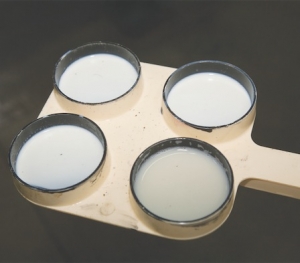Dairy NZ’s senior scientist specialising in mastitis management, Dr Jane Lacy-Hulbert, says the minimum should be to check every colostrum cow daily, and ideally, twice a day, for the four day colostrum period.
“Try to find and treat new clinical cases that have happened at calving or just after. If you pick them up in the colostrum cows it will help keep infection in the herd down for the whole season.”
Each quarter should be stripped and checked for clots.
“When it (colostrum) goes ‘junkety’ and the wrong colour, you know there’s something wrong.”
Making sure teats are clean, particularly for the first milking, is a must.
“Wash and dry them. If a cow’s been lying in the mud to calve, this won’t be good for mastitis.”
Putting cows onto clean pasture to calve will minimise the mess.
“A common way is to put the ones you think will calve overnight or that day through the fence onto the next break.”
Besides posing a mastitis risk, soil on teats rubs during milking, causing abrasions and discomfort which, depending on severity of damage, may persist for many milkings.
Incorrect milking system set-up can be another cause of teat damage, so arrange for machine test to check vacuum settings, pulsation rates and ratios, and liner fittings to correct a a persistent cause of damaged teats.
After milking, apply a teatspray. Make sure that your teat spray meets the new requirements for avoiding chemical residues in milk. Some products have been re-registered with AVCM to reduce the risk of causing residues in milk. “Contact your teat spray supplier or your milk processor. They’ll be most aware of which products are approved and which are not.”
Ensuring the correct quantity per cow is applied, and at the right concentration, is also important to minimise residue risk while ensuring the spray does its job.
In terms of product choice, Lacy-Hulbert refuses to be drawn, saying there are “horses for courses.”
“If it’s a registered, AVCM- approved teat spray, that’s okay by us.”
Checking coverage, whether using manual application or an automated system, is important.
“The best teat spray is the teat spray that gets on the teat. Teat spray on the body or legs is not going to help prevent mastitis!”
Hold a piece of card at udder height to check the spray pattern of automated systems, or with a manual gun, spray the card or wall to check there’s a good cone of droplets.
“Are you getting a good cone or is it a narrow squirt or all dribbly?”
A paper towel wrapped round each teat can be used to find out if sprays are covering all teats.
At calving the most likely cause of mastitis is Streptococcus uberis but taking samples from some clinical cases, using aseptic technique, and storing them frozen for possible analysis later is a good idea so that if a persistent or wider problem develops, the cause of early cases can be checked.
“There’s advice on how to do this in the Healthy Udder guide or your vet will be able to tell you what to do.”
When mastitis is found, Lacy-Hulbert says the “MRS T” routine is a good one to follow: Mark the cow; Record her number and planned treatment; Separate from herd; and then Treat.
Separating and milking later helps prevent spreading mastitis through milking equipment, and reduces the risk of mastitis milk, or worse still, penicillin treated milk, going in the vat, she explains.
















